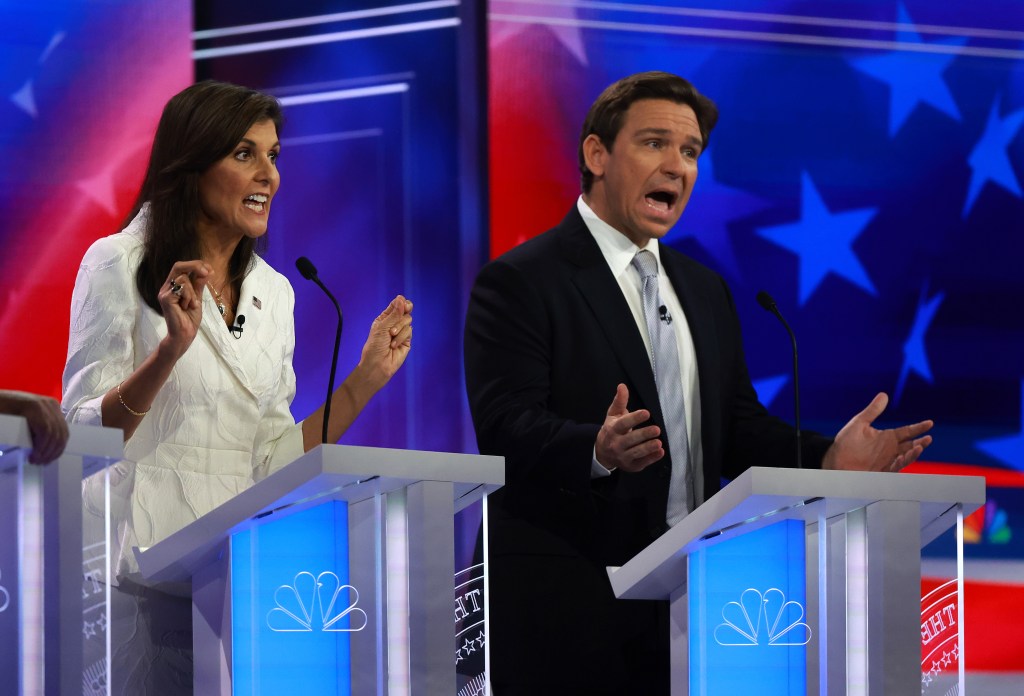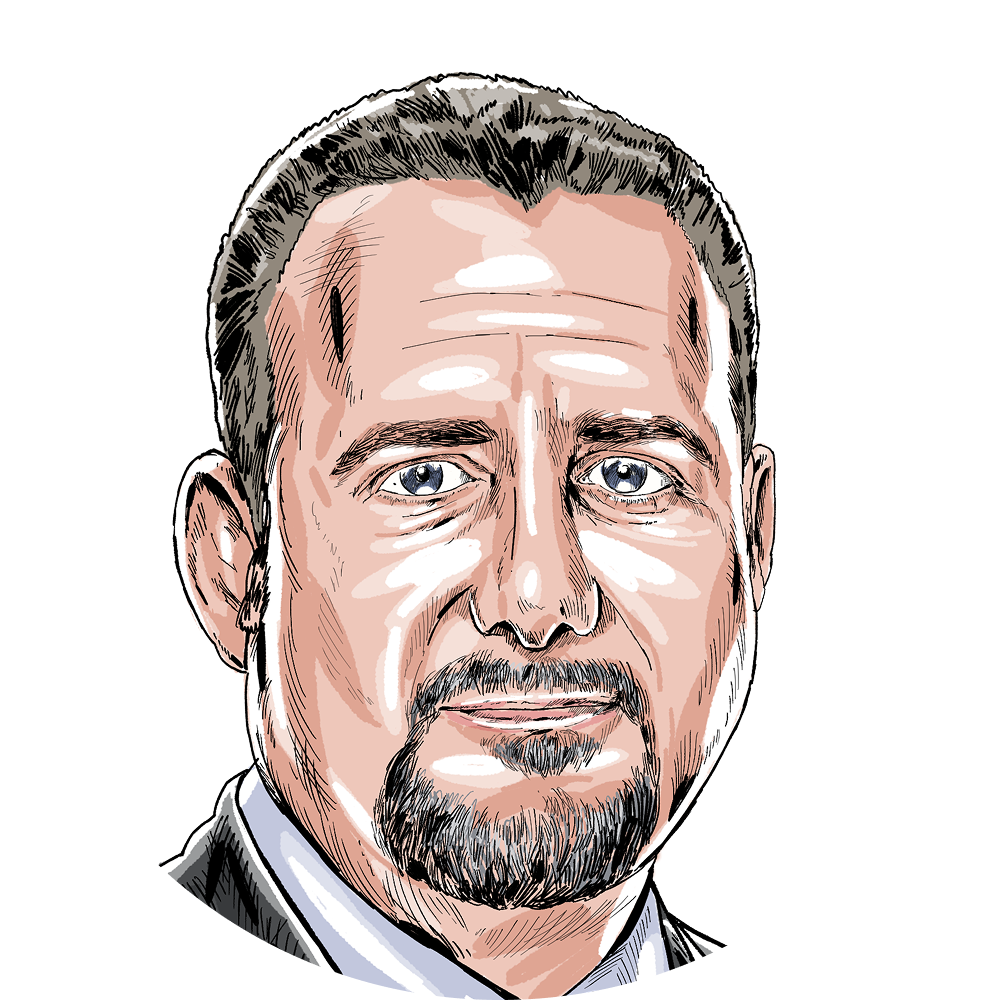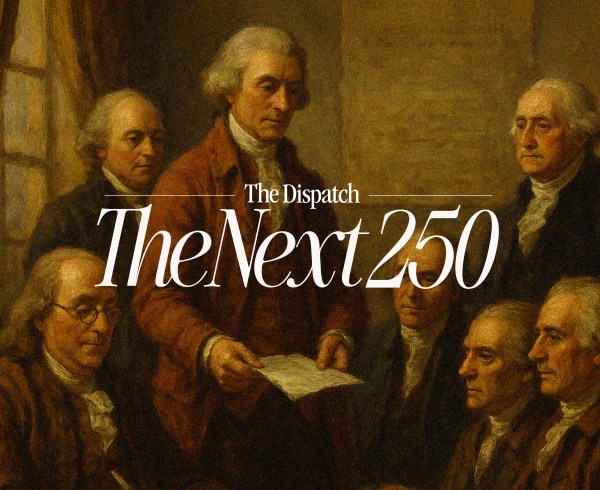MIAMI—The stage keeps shrinking; Donald Trump’s lead keeps growing. That’s the scenario facing Republican candidates after yet another televised debate seemingly failed to catapult any of them into real contention with the former president in the race for the GOP presidential nomination.
There were only five candidates on stage in South Florida on Wednesday, down from eight in the first debate and seven in the second. Throughout, the sparring over domestic and foreign policy has been substantive, budding rivalries have intensified, and the jockeying for second place has ratcheted up. Nikki Haley is rising; Vivek Ramaswamy is falling; Ron DeSantis is stuck in neutral.
None of it, including the recent withdrawals of former Vice President Mike Pence and Sen. Tim Scott of South Carolina, has threatened Trump’s standing atop the field or produced a consensus alternative. And upon the conclusion of the third debate, conversations with the campaigns chasing the former president suggest they don’t have an obvious strategy for altering this essential dynamic of the GOP primary—other than to have faith that what hasn’t worked so far will eventually pay off.
Time is short; voting begins with the January 15 Iowa caucuses.
In the spin room following the debate, Haley campaign spokeswoman Olivia Perez-Cubas tried to separate the former South Carolina governor and ex-U.S. ambassador to the United Nations from the pack. “In this debate,” she told The Dispatch, “[Haley] showed that she is the Trump alternative, and she’s the Biden alternative.”
But Haley is also trailing Trump by more than 30 percentage points in Iowa, New Hampshire, and South Carolina—and nearly 50 points nationally. What is her campaign’s plan to close the gap? “I think it is doing what we are doing,” Perez-Cubas said. “You do as well as you can in Iowa. You go into New Hampshire eight days later and you do as well as you can in New Hampshire—the field is consolidating, it is already consolidating—and then she enters South Carolina.”
“It’s not going to happen overnight,” Perez-Cubas adds. “But for us, it’s slow and steady.”
Of course, Haley isn’t alone in attempting to explain the, as yet, unexplainable.
DeSantis is Haley’s chief rival in the battle for second place. He narrowly leads her in Iowa while trailing her in both New Hampshire and South Carolina. So, the Florida governor is clearly contending to win this particular sub-contest of the Republican primary. Indeed, the DeSantis campaign is investing time and resources to undermine Haley, in order to chart a path to Trump.
But DeSantis’ challenge is greater than edging out his fellow governor. To start, he has to at least make a big enough dent in Trump’s support among GOP voters that the former president feels compelled to participate in an upcoming televised debate. And like Haley, it’s unclear the governor has a viable plan to get from here to there, even after scoring the backing of Iowa Gov. Kim Reynolds, perhaps the most coveted endorsement of any 2024 caucus or primary.
DeSantis delivered another debate performance last week that was roundly praised by voters in snap polls conducted immediately afterward, but does his campaign have a strategy to make the primary an actual race? “We’re going to let the caucuses start this process,” Ryan Tyson, a top DeSantis adviser, told The Dispatch. “We’re actually going to let people show up and make a decision. That’s where this begins, and we really like what we’re seeing on that front.”
Considering DeSantis’ poll numbers are declining at worst and encased in amber at best, what is his campaign seeing that warrants such optimism? Tyson’s theory of the case is that the current polling reflects passive engagement in the process and, based on his experience on the trail in Iowa, where he is now spending most of his time, the governor’s support will spike once likely Republican caucusgoers truly dial in and decide whom to vote for.
“People are tired of politics. It’s in their face all the time,” Tyson said. “All I ask is, just go walk around Iowa, just spend a little time walking around a Machine Shed—a normal place. I’m telling you, they’ll start to wake up soon, and we like our chances when they do.”
The obstacle confronting Trump’s Republican opponents is daunting, and plain to see in the publicly available data. On August 23, the day of the first debate, the former president led among GOP voters with an average of 55.4 percent in national polls. On November 8, after more than two months of campaigning and two high-stakes televised debates, his share of support had … climbed to 58.5 percent. A similar story is playing out in the early states: Trump’s support in Iowa increased during that same period, from 43.2 percent to 47.3 percent.
Meanwhile, GOP challengers’ preferred line of attack on Trump—that he is unelectable—has been largely neutered this fall. Over the past 10 days, national polls and surveys of key battleground states show the 45th president beating his successor. Multiple criminal indictments, some of which could land Trump in jail, have failed to damage his viability—in both the Republican primary and the general election.
That is quite the predicament for Haley and DeSantis, but also for Ramaswamy, former New Jersey Gov. Chris Christie, and North Dakota Gov. Doug Burgum. Those who remain insist the race is not over, but none of them can identify exactly what will deflate Trump, or exactly what they are going to do to surpass him.
Team Christie’s optimism is based, at least in part, on its belief that Trump’s nearly 60 percent support in current polling is actually a sign of weakness—if you treat Trump as a quasi-incumbent. It’s a highly questionable claim. “We’re getting there,” Christie adviser Mike DuHaime insisted, just minutes after the conclusion of the most recent debate.
Shortly after, former Sen. Cory Gardner—in the spin room on behalf of the Scott campaign—described the effort to block Trump from the nomination as a solvable math equation. “We’ve got seven out of 10 voters who are willing to vote for somebody other than Donald Trump,” the Colorado Republican said, apparently referring to recent polling. “We have five out of 10 right now who are actually doing it on paper. We need to make sure that the next two voters to get to that seven out of 10 actually see, hear, and feel Tim Scott’s message.”
Scott, of course, was ultimately unable to crack the formula, dropping out of the race four days later. And thus far, there’s little indication the other candidates are any closer to figuring it out.







Please note that we at The Dispatch hold ourselves, our work, and our commenters to a higher standard than other places on the internet. We welcome comments that foster genuine debate or discussion—including comments critical of us or our work—but responses that include ad hominem attacks on fellow Dispatch members or are intended to stoke fear and anger may be moderated.
With your membership, you only have the ability to comment on The Morning Dispatch articles. Consider upgrading to join the conversation everywhere.